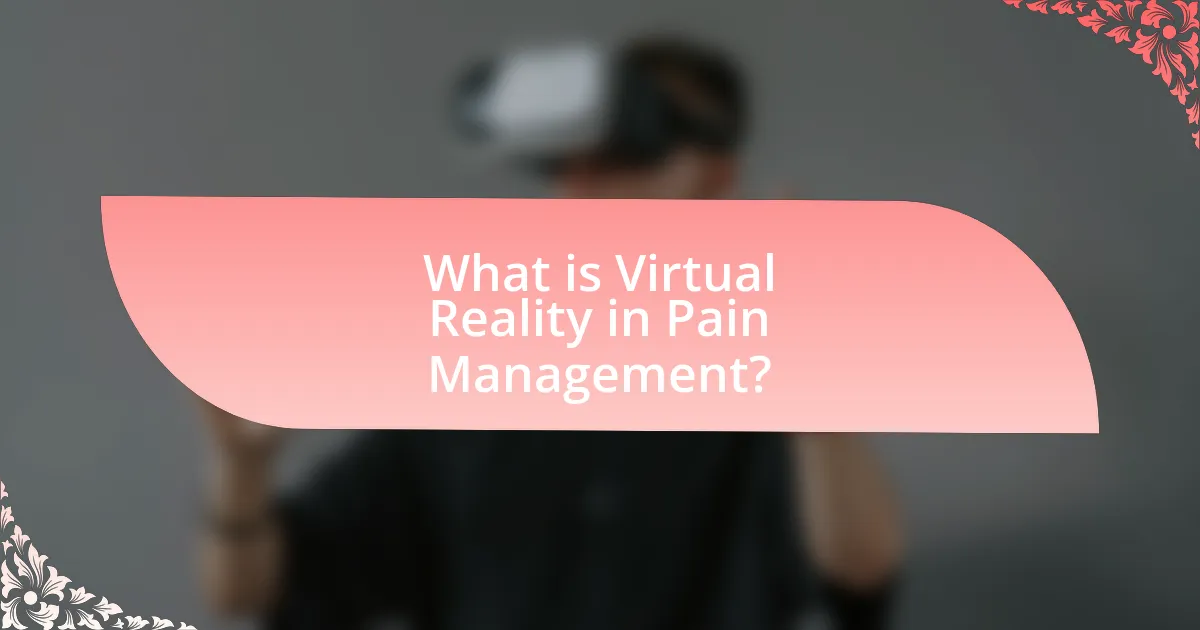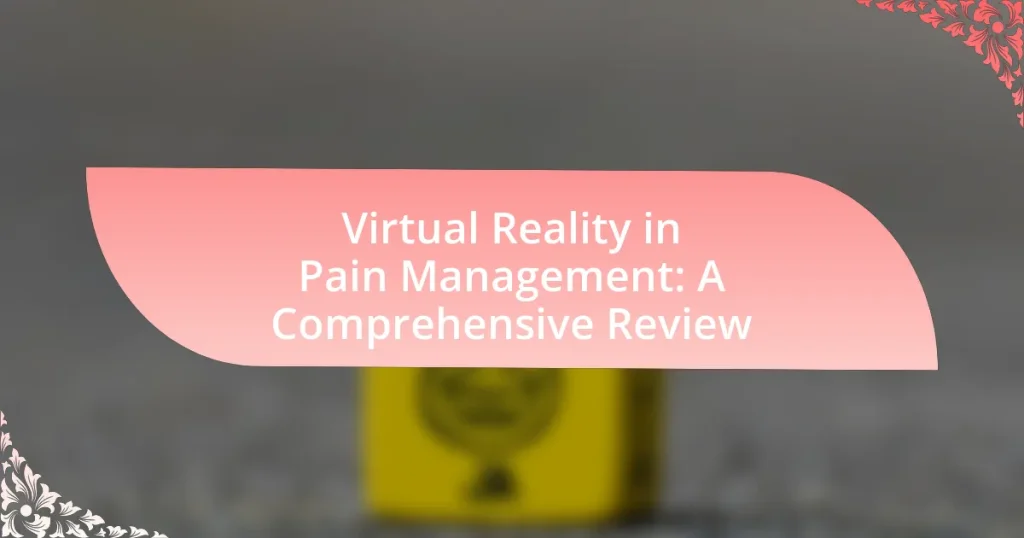Virtual Reality (VR) in Pain Management is an innovative therapeutic approach that employs immersive virtual environments to alleviate pain perception and enhance patient comfort. This comprehensive review examines the mechanisms through which VR functions in pain management, including distraction, cognitive engagement, and altered pain perception. Key components of VR systems, such as immersive environments and biofeedback mechanisms, are discussed, along with the types of pain that can be effectively managed using VR. The article also highlights the psychological mechanisms behind VR’s effectiveness, the benefits of patient engagement, and the current applications of VR in healthcare settings, while addressing potential risks and challenges in implementation.

What is Virtual Reality in Pain Management?
Virtual Reality in Pain Management is a therapeutic approach that utilizes immersive virtual environments to alleviate pain perception and enhance patient comfort. This method engages patients in interactive experiences that distract them from pain, leading to reduced pain intensity and anxiety. Research has shown that Virtual Reality can significantly lower pain levels in various medical settings, including during wound care and surgical procedures, by providing a compelling distraction and promoting relaxation. Studies indicate that patients using Virtual Reality report a decrease in pain scores by up to 50%, demonstrating its effectiveness as a complementary pain management strategy.
How does Virtual Reality technology function in the context of pain management?
Virtual Reality (VR) technology functions in pain management by immersing patients in a simulated environment that distracts them from pain and alters their perception of discomfort. This immersive experience engages the brain’s attention, reducing the focus on pain signals and promoting relaxation. Research has shown that VR can significantly lower pain levels in various medical settings, such as during wound care or physical therapy. For instance, a study published in the journal “Pain Medicine” found that patients using VR during painful procedures reported a 24% reduction in pain intensity compared to those who did not use VR. This evidence supports the effectiveness of VR as a non-pharmacological intervention in pain management.
What are the key components of Virtual Reality systems used in pain management?
The key components of Virtual Reality systems used in pain management include immersive environments, interactive simulations, and biofeedback mechanisms. Immersive environments create a sense of presence, allowing patients to engage in virtual worlds that distract from pain. Interactive simulations enable patients to participate in activities that require focus and movement, further diverting attention from discomfort. Biofeedback mechanisms provide real-time data on physiological responses, helping patients learn to manage their pain through relaxation techniques. These components work together to enhance the effectiveness of pain management strategies, as evidenced by studies showing significant reductions in pain perception during VR interventions.
How do these components interact to create immersive experiences?
Components such as visual stimuli, auditory feedback, and haptic sensations interact synergistically to create immersive experiences in virtual reality. Visual stimuli provide a realistic environment that captures attention, while auditory feedback enhances the sense of presence by simulating real-world sounds. Haptic sensations, through tactile feedback, reinforce the visual and auditory elements, making interactions feel more authentic. Research indicates that these combined sensory inputs can significantly distract patients from pain, as evidenced by studies showing a reduction in perceived pain levels during VR interventions in clinical settings. This multi-sensory integration is crucial for effective pain management, as it engages the brain’s attention networks, thereby altering pain perception.
What types of pain can be managed using Virtual Reality?
Virtual Reality can manage various types of pain, including acute pain, chronic pain, procedural pain, and phantom limb pain. Research indicates that Virtual Reality effectively reduces pain perception by distracting patients and altering their sensory experiences. For instance, a study published in the journal “Pain Medicine” by Hoffman et al. demonstrated that patients undergoing painful procedures experienced significant pain relief when immersed in a Virtual Reality environment. Additionally, chronic pain patients have reported reduced pain levels and improved quality of life through Virtual Reality interventions, as highlighted in a systematic review in “Frontiers in Psychology” by Mallari et al. These findings confirm the efficacy of Virtual Reality in pain management across different pain types.
How effective is Virtual Reality for acute pain relief?
Virtual Reality (VR) is highly effective for acute pain relief, with studies demonstrating significant reductions in pain perception. Research published in the journal “Pain Medicine” indicates that VR can decrease pain levels by up to 50% in various clinical settings, including burn care and post-operative recovery. The immersive nature of VR distracts patients from their pain, engaging them in interactive environments that promote relaxation and reduce anxiety. This distraction mechanism has been validated through multiple clinical trials, confirming VR’s role as a viable adjunct to traditional pain management strategies.
What evidence supports the use of Virtual Reality for chronic pain management?
Evidence supporting the use of Virtual Reality (VR) for chronic pain management includes multiple clinical studies demonstrating its effectiveness in reducing pain perception. For instance, a meta-analysis published in the journal “Pain Medicine” in 2020 by Mallari et al. found that VR interventions significantly decreased pain levels in patients with various chronic pain conditions, with effect sizes indicating moderate to large reductions in pain. Additionally, a randomized controlled trial conducted by Hoffman et al. in 2011 showed that patients using VR during painful procedures reported lower pain scores compared to those receiving standard care. These findings collectively underscore the potential of VR as a viable adjunctive treatment for managing chronic pain.
What are the psychological mechanisms behind Virtual Reality’s effectiveness in pain relief?
Virtual Reality (VR) effectively alleviates pain through several psychological mechanisms, primarily distraction, cognitive engagement, and altered perception of pain. Distraction occurs as VR immerses users in engaging environments, diverting attention away from pain stimuli. Cognitive engagement enhances this effect by requiring users to focus on tasks within the VR experience, which can reduce the perception of pain intensity. Additionally, VR can alter the brain’s processing of pain signals, as evidenced by studies showing that immersive experiences can lead to decreased activity in pain-related brain areas. Research published in the journal “Pain” by Hoffman et al. (2000) demonstrated that patients using VR during painful procedures reported significantly lower pain levels compared to those who did not use VR, highlighting the effectiveness of these psychological mechanisms in pain relief.
How does distraction theory apply to Virtual Reality in pain management?
Distraction theory applies to Virtual Reality (VR) in pain management by utilizing immersive environments to divert patients’ attention away from pain stimuli. This approach has been supported by studies showing that engaging patients in VR experiences can significantly reduce their perception of pain. For instance, a meta-analysis published in the journal “Pain Medicine” found that VR interventions led to a 30-50% reduction in pain levels across various medical procedures. By focusing on interactive and engaging VR content, patients experience a decrease in pain perception, demonstrating the effectiveness of distraction theory in clinical settings.
What role does patient engagement play in the effectiveness of Virtual Reality?
Patient engagement significantly enhances the effectiveness of Virtual Reality (VR) in pain management. Engaged patients are more likely to actively participate in VR interventions, leading to improved outcomes such as reduced pain perception and increased coping strategies. Research indicates that when patients are involved in their treatment process, they report higher satisfaction and better adherence to VR protocols, which can amplify the therapeutic effects of VR. For instance, a study published in the Journal of Pain Research found that patients who were actively engaged in their VR sessions experienced a 30% greater reduction in pain compared to those who were less involved. This demonstrates that patient engagement is a critical factor in maximizing the benefits of VR for pain management.

What are the benefits of using Virtual Reality in Pain Management?
The benefits of using Virtual Reality in Pain Management include significant reductions in pain perception, enhanced patient engagement, and improved coping strategies. Research indicates that immersive VR experiences can distract patients from pain, leading to a decrease in reported pain levels by up to 50% in some cases. A study published in the journal “Pain Medicine” by Hoffman et al. (2011) demonstrated that patients using VR during painful procedures experienced less pain and anxiety compared to those who did not use VR. Additionally, VR can facilitate relaxation and promote a sense of control, which are crucial for effective pain management.
How does Virtual Reality improve patient outcomes in pain management?
Virtual Reality (VR) improves patient outcomes in pain management by providing immersive experiences that distract patients from pain and reduce anxiety. Research indicates that VR can lead to significant reductions in pain perception; for instance, a study published in the journal Pain Medicine found that patients using VR during painful procedures reported a 24% decrease in pain levels compared to those who did not use VR. Additionally, VR has been shown to enhance emotional well-being and increase patient engagement in their treatment, further contributing to improved outcomes.
What are the reported benefits from patients using Virtual Reality for pain relief?
Patients using Virtual Reality (VR) for pain relief report several benefits, including significant reductions in pain perception, enhanced relaxation, and improved emotional well-being. Research indicates that VR can distract patients from pain by immersing them in engaging virtual environments, which has been shown to lower pain scores by up to 50% in some clinical settings. Additionally, studies have demonstrated that VR can reduce anxiety and stress, further contributing to pain relief. For instance, a study published in the journal “Pain Medicine” found that patients undergoing painful procedures experienced less pain and anxiety when using VR compared to traditional methods.
How does Virtual Reality compare to traditional pain management techniques?
Virtual Reality (VR) offers a novel approach to pain management that differs significantly from traditional techniques such as medication, physical therapy, and cognitive behavioral therapy. VR immerses patients in a controlled, engaging environment that can distract from pain, reduce anxiety, and promote relaxation, which is often more effective than conventional methods that primarily focus on pharmacological interventions. Research indicates that VR can lead to a 24% to 50% reduction in pain perception during procedures, as demonstrated in studies like the one published in the journal Pain Medicine by Hoffman et al. (2011), which showed that patients using VR reported lower pain levels compared to those receiving standard care. This evidence highlights VR’s potential as a complementary tool in pain management, particularly for acute and chronic pain scenarios.
What are the potential risks or limitations of using Virtual Reality in pain management?
The potential risks or limitations of using Virtual Reality in pain management include technological issues, individual variability in response, and the potential for adverse psychological effects. Technological issues can arise from equipment malfunctions or inadequate user experience, which may hinder the effectiveness of pain relief. Individual variability means that not all patients respond positively to Virtual Reality, as factors such as age, mental health status, and personal preferences can influence outcomes. Additionally, some users may experience motion sickness or anxiety during Virtual Reality sessions, which can exacerbate discomfort rather than alleviate it. These limitations highlight the need for careful consideration and tailored approaches when implementing Virtual Reality in pain management strategies.
What challenges do healthcare providers face when implementing Virtual Reality?
Healthcare providers face several challenges when implementing Virtual Reality (VR), including high costs, technical limitations, and the need for specialized training. The initial investment for VR equipment and software can be substantial, often deterring healthcare facilities from adoption. Additionally, technical limitations such as software compatibility and hardware requirements can complicate integration into existing systems. Furthermore, healthcare professionals require specialized training to effectively use VR technology, which can be time-consuming and resource-intensive. These factors collectively hinder the widespread adoption of VR in healthcare settings.
How can adverse effects of Virtual Reality be mitigated in clinical settings?
Adverse effects of Virtual Reality (VR) in clinical settings can be mitigated through careful design and implementation of VR experiences. Strategies include optimizing the duration of VR sessions to prevent discomfort, ensuring appropriate content that aligns with patients’ psychological readiness, and providing breaks to reduce symptoms of motion sickness. Research indicates that gradual exposure to VR environments can help acclimate users, thereby minimizing adverse reactions. Additionally, employing user-friendly interfaces and maintaining a supportive environment can enhance patient comfort and engagement, further reducing negative effects.

How is Virtual Reality being integrated into clinical practice for pain management?
Virtual Reality (VR) is being integrated into clinical practice for pain management through immersive experiences that distract patients from pain and anxiety during medical procedures. Studies have shown that VR can significantly reduce pain perception; for instance, a systematic review published in the journal “Pain Medicine” found that patients using VR during painful procedures reported a 30-50% reduction in pain levels. Additionally, VR applications are being utilized in rehabilitation settings, where patients engage in virtual environments that promote movement and reduce discomfort, further enhancing their recovery process. This integration is supported by clinical trials demonstrating the efficacy of VR in various pain management scenarios, including burn care and chronic pain treatment.
What are the current applications of Virtual Reality in healthcare settings?
Current applications of Virtual Reality (VR) in healthcare settings include pain management, surgical training, exposure therapy, and rehabilitation. In pain management, VR has been shown to reduce pain perception during medical procedures by immersing patients in engaging virtual environments, which distracts them from discomfort. A study published in the journal “Pain Medicine” demonstrated that patients using VR during wound care reported a 50% reduction in pain levels compared to those who did not use VR. In surgical training, VR simulations allow medical professionals to practice procedures in a risk-free environment, enhancing their skills and confidence. Exposure therapy for phobias and PTSD utilizes VR to create controlled environments where patients can confront their fears safely. Additionally, VR is employed in rehabilitation programs, helping patients regain motor skills through interactive exercises that motivate and engage them.
How are hospitals and clinics utilizing Virtual Reality for pain management?
Hospitals and clinics are utilizing Virtual Reality (VR) for pain management by immersing patients in virtual environments that distract them from pain and anxiety during medical procedures. This approach has been shown to reduce the perception of pain, as evidenced by studies indicating that patients using VR during procedures report lower pain scores compared to those who do not use VR. For instance, a study published in the journal “Pain Medicine” found that VR significantly decreased pain levels in patients undergoing burn wound care. Additionally, VR has been effectively used in pediatric settings, where children undergoing painful treatments experience less distress and discomfort when engaged in interactive VR experiences.
What training is required for healthcare professionals to use Virtual Reality effectively?
Healthcare professionals require specialized training in both the technical aspects of Virtual Reality (VR) systems and the therapeutic applications of VR in clinical settings. This training typically includes understanding VR hardware and software, learning how to integrate VR into treatment protocols, and gaining skills in patient interaction and monitoring during VR sessions. Research indicates that effective training programs enhance the ability of healthcare providers to utilize VR for pain management, leading to improved patient outcomes. For instance, a study published in the Journal of Pain Research highlights that healthcare professionals who underwent comprehensive VR training reported increased confidence and competence in using VR technologies for pain relief.
What future developments can be expected in Virtual Reality for pain management?
Future developments in Virtual Reality (VR) for pain management will likely include enhanced immersive experiences, personalized treatment protocols, and integration with biofeedback mechanisms. Research indicates that advancements in VR technology, such as improved graphics and haptic feedback, will create more realistic environments that can effectively distract patients from pain. Additionally, studies suggest that personalized VR experiences tailored to individual patient needs can increase the efficacy of pain relief. For instance, a study published in the journal “Pain Medicine” by Hoffman et al. (2019) demonstrated that customized VR interventions significantly reduced pain levels in patients undergoing medical procedures. Furthermore, the incorporation of biofeedback, where patients receive real-time data about their physiological responses, could enhance the effectiveness of VR by allowing users to learn pain management techniques actively.
How might advancements in technology enhance Virtual Reality applications in pain management?
Advancements in technology can enhance Virtual Reality (VR) applications in pain management by improving immersion, interactivity, and personalization of therapeutic experiences. Enhanced graphics and haptic feedback technologies create more realistic environments, which can distract patients from pain and reduce their perception of discomfort. For example, studies have shown that VR environments with high-quality graphics can lead to a significant reduction in pain levels during medical procedures. Additionally, machine learning algorithms can analyze patient responses in real-time, allowing for tailored VR experiences that adapt to individual pain thresholds and preferences, thereby increasing the effectiveness of pain management strategies.
What research is currently being conducted to explore new uses of Virtual Reality in pain management?
Current research exploring new uses of Virtual Reality (VR) in pain management includes studies investigating its effectiveness in reducing pain perception during medical procedures and chronic pain conditions. For instance, a study published in the journal “Pain Medicine” by Hoffman et al. (2020) demonstrated that VR can significantly decrease pain levels in patients undergoing burn wound care. Additionally, research by Mallari et al. (2021) in “Frontiers in Virtual Reality” examined VR’s role in managing fibromyalgia symptoms, showing promising results in pain reduction and improved quality of life. These studies highlight the potential of VR as a non-pharmacological intervention in pain management.
What best practices should be followed when implementing Virtual Reality in pain management?
Best practices for implementing Virtual Reality (VR) in pain management include ensuring a user-friendly interface, customizing experiences to individual patient needs, and integrating VR with traditional pain management therapies. A user-friendly interface enhances patient engagement and reduces anxiety, which is crucial for effective pain relief. Customization allows for tailored experiences that address specific pain types and patient preferences, leading to improved outcomes. Integrating VR with traditional therapies, such as cognitive-behavioral techniques, has been shown to enhance overall effectiveness, as evidenced by studies indicating that combined approaches can lead to greater reductions in pain perception and improved patient satisfaction.


